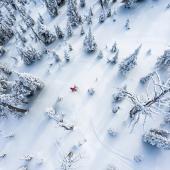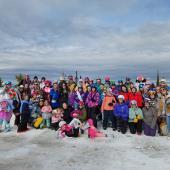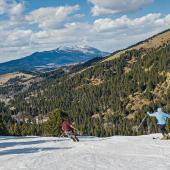Sidecountry Silliness
The greatest gift given to Bozeman-area skiers since the Lone Peak Tram has certainly endured some growing pains during its infant years. When the Slushman’s lift started turning three seasons ago, it immediately opened vast acreage of exciting, lift-accessed terrain, and it ushered in an open-boundary policy to the delight of most Bridger Bowl skiers. The terrain that beckoned to ridge enthusiasts from beyond the ropes no longer required a formidable skin from the access gates on the lower mountain, nor alternatively, was a pass-pulling offense if you chose to take a chance from the top. Yet, despite the signs warning out-of-bounds skiers of the dangers, sidecountry shenanigans abound.
The Bozeman ski community was incredibly lucky that no one was buried in the massive Saddle Peak slide two years ago; when the debris settled and all were accounted for, the hope was that a few lessons were learned. Yet riders still drop in on top of other parties, ski the open face two or three at a time, and traverse all the way out to the shoulder under yawning cornices to get fresh tracks. Sure, it’s great that everyone has a beacon out there, but there is no requirement that you know how to turn it to “search” mode.
One of the topographic features of the main face that increases its danger is the steep rollover just a few hundred feet off the summit. A proven starting zone for a slide due to the pitch, it’s impossible to see your partner from above if they do get carried down the face. While this should discourage novice backcountry skiing, it seems to just encourage recklessness—like the first-time Saddle Peak skier who watched his partner’s powder trail disappear and then asked our party, “I just go down there, right?” Bristling, we diplomatically explained that “down there” included some very large cliffs he would be wise to avoid.
The unconventional lift seems to encourage some very unconventional behavior in-bounds as well. When the Slushman’s lift opens, whether it be the day after a storm or the following day (despite the incessant griping endured by patrollers, this often means a bonus powder day), the mad dash when the gates open often resembles Pamplona’s running of the bulls. In this case other skiers and boarders are the bulls, and though I’ve never been gored by a thrashing horn, I’m guessing a ski tip to the ribs at high velocity is probably the next worst thing. Just ask the guy who was knocked off the cat track last season by a few charging powder hounds and blew out his knee. (I suppose he’s lucky to have landed on snow and not a cobblestone street.)
Once the thronging mass of humanity is organized into the controlled chaos of the corral, the epic lines that form on a big storm day seem to encourage scandalous behavior as well. We’ve all marveled—and grumbled—at the single skier who comes speeding around the corner from the south just as a pole goes up in the air down front. How could that guy about to get on the lift possibly be a single?! He must have ignored ten hopefuls as he made his way to the front, waiting for his buddy to return from a distant Saddle lap. I am often impressed by the military-like precision used to attack the Slushman’s snow.
The crowds and the chaos of the Slushman’s lift can be worth it, of course. The terrain skiable right from the lift is some of the best at Bridger, with its consistent pitch and exciting lines. Yet the greatest asset created by the Slushman’s sensation might just be the quiet, and civility, found on the ridge when the mass migration heads south.












